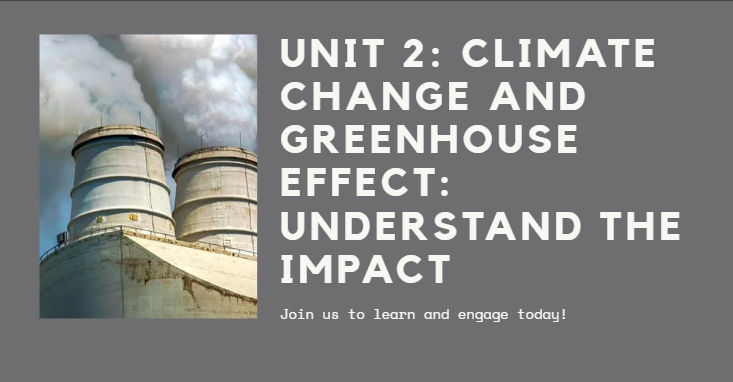PHYSICS S6 UNIT 2: CLIMATE CHANGE AND GREENHOUSE EFFECT.

About Course
Climate change and the greenhouse effect are closely related phenomena that describe the warming of our planet.
The Greenhouse Effect
The greenhouse effect is a natural process that is essential for life on Earth. Certain gases in the Earth’s atmosphere, known as greenhouse gases (GHGs), act like the glass panels of a greenhouse. They allow sunlight to pass through and warm the Earth’s surface. As the Earth warms, it radiates some of this energy back towards space as infrared heat. Greenhouse gases absorb a significant portion of this outgoing heat, trapping it in the atmosphere and preventing it from escaping into space. This natural process keeps the Earth’s average temperature at about 15°C (59°F), which is crucial for supporting life. Without it, the Earth’s average temperature would be around -18°C (0°F), making it too cold for most life forms.
Key greenhouse gases include:
-
Water vapor (H2O)
-
Carbon dioxide (CO2)
-
Methane (CH4)
-
Nitrous oxide (N2O)
-
Ozone (O3)
-
Synthetic fluorinated gases (like HFCs, PFCs, CFCs, and SF6)
Climate Change (and the Enhanced Greenhouse Effect).
Climate change refers to long-term shifts in temperatures and weather patterns. While natural factors like changes in solar activity or volcanic eruptions can influence climate, since the Industrial Revolution (around 1750), human activities have become the primary driver of climate change.
The main way human activities contribute to climate change is by enhancing the natural greenhouse effect. This “enhanced greenhouse effect” occurs when humans release excessive amounts of greenhouse gases into the atmosphere, primarily through:
-
Burning fossil fuels: Coal, oil, and natural gas are burned for electricity, transportation, and industrial processes, releasing large amounts of carbon dioxide.
-
Deforestation: Forests absorb carbon dioxide from the atmosphere. Cutting down trees reduces this natural “carbon sink” and releases stored carbon.
-
Agriculture and livestock: Agricultural practices (e.g., use of fertilizers) release nitrous oxide, and livestock (e.g., cattle) produce methane.
-
Waste and landfills: Decomposing organic waste in landfills generates methane.
-
Industrial processes and chemicals: Various industrial activities and the use of certain chemicals (like refrigerants) release potent GHGs.
These increased concentrations of GHGs trap more heat than naturally occurs, leading to a rapid warming of the planet. This warming is often referred to as global warming, which is a key aspect of climate change, but climate change encompasses broader changes to precipitation, wind patterns, and extreme weather events.
Impacts of Climate Change
The impacts of climate change are widespread and severe:
-
Rising global temperatures: The last decade (2011-2020) was the warmest on record, and each of the last four decades has been warmer than any previous decade since 1850.
-
More severe storms: Higher temperatures lead to more moisture evaporation, exacerbating extreme rainfall and flooding. Warmer ocean temperatures intensify tropical storms like hurricanes and typhoons.
-
Increased droughts and water scarcity: Climate change alters water availability, leading to more frequent and intense droughts, affecting agriculture and increasing the risk of famine.
-
Melting ice and rising sea levels: Glaciers and polar ice sheets are melting at an accelerated rate, contributing to rising sea levels that threaten coastal communities and islands.
-
Ocean acidification: The ocean absorbs excess carbon dioxide, which makes it more acidic, endangering marine life and coral reefs.
-
Loss of biodiversity: Many plant and animal species are at risk of extinction as their habitats change rapidly due to shifting climates, wildfires, and extreme weather.
-
Impacts on food security: Changes in temperature and precipitation patterns, along with increased pests and diseases, threaten crop yields and livestock, leading to food shortages and poor nutrition.
-
Health impacts: Heat-related illnesses, spread of vector-borne diseases, and impacts on air and water quality affect human health.
-
Displacement of populations: Extreme weather events and rising sea levels can force communities to relocate.
Solutions to Climate Change
Addressing climate change requires a two-pronged approach:
-
Mitigation: Reducing and stabilizing the levels of heat-trapping greenhouse gases in the atmosphere. This involves:
-
Transitioning to renewable energy: Shifting away from fossil fuels to sources like solar, wind, hydropower, and geothermal energy for electricity generation and transportation.
-
Improving energy efficiency: Reducing energy consumption in homes, industries, and transportation through better insulation, LED lighting, smart technologies, and efficient vehicles.
-
Sustainable land use and forestry: Halting deforestation, promoting reforestation and afforestation, and adopting sustainable agricultural practices that reduce emissions and enhance carbon absorption.
-
Waste management: Reducing waste, promoting recycling, and capturing methane from landfills.
-
Technological advancements: Developing and deploying technologies for carbon capture and storage.
-
-
Adaptation: Adjusting to the actual or expected impacts of climate change that are already unavoidable. This includes:
-
Building resilient infrastructure: Developing flood defenses, improving stormwater management, and constructing buildings that can withstand extreme weather.
-
Improving water management: Implementing strategies to manage water scarcity and ensure water availability.
-
Developing climate-resilient agriculture: Creating new crop varieties and farming methods that can withstand changing climate conditions.
-
Early warning systems: Establishing systems to prepare for and respond to extreme weather events.
-
Protecting and restoring ecosystems: Strengthening natural systems that provide protection and support for human communities.
-
Course Content
SCIENTIFIC PROCESS BEHIND CLIMATE CHANGE.
-
Black body radiation.
14:47 -
Laws of Black Body Radiation.
21:31 -
Black Body Radiation Curves.
22:16 -
Checking my Progress.
35:25
INTENSITY OF THE SUN’S RADIATION REACHING PLANETS.
GREENHOUSE EFFECTS.
CLIMATE CHANGE.
CLIMATE CHANGE MITIGATION.
END UNIT ASSESSMENT
Final Unit Exam
Student Ratings & Reviews

